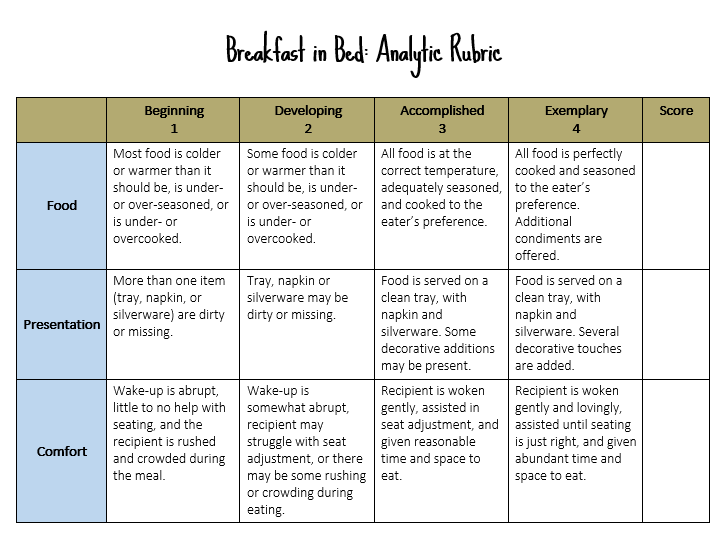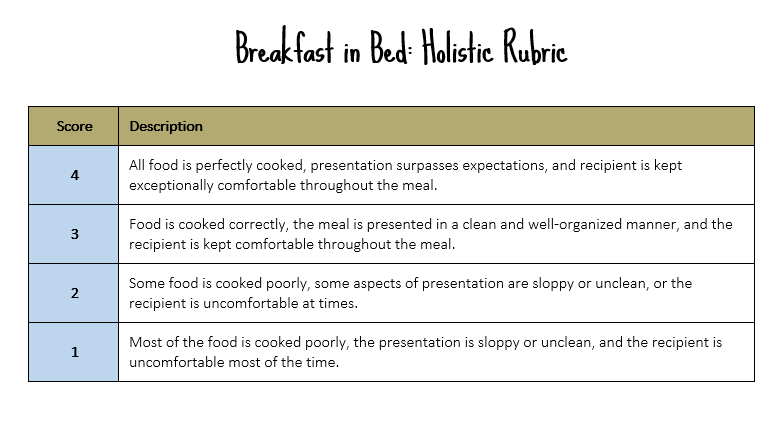Rubrics: The Rhyme and Reason
Written by Jori Marshall & Austin Palaad
August 6, 2019 • 2 minute read
As an instructor, it is easy to believe that you have already done the job of communicating clear expectations to your students regarding their grades at the start of a course. However, students can become frustrated whenever course assignments have been graded and they’ve received results that fall short of what they feel they deserve. This may lead to perceptions that as an instructor, you grade inconsistently or unfairly. It is highly likely this is not the case and doesn’t describe your assessment practices.
However, a lack of clear and explicit standards can allow your expectations for class assignments to be subject to student interpretation. Rubrics are a common and effective source of assessment; helping to avoid the misconception that there is a lack of rhyme and reason to an instructors grading process. Rubrics are conventionally designed and presented in the format of a table that details an assignment’s grading metrics. They serve as a document that can clearly articulate the criteria used to judge a set of standards that are required for an assessment and aid students in strengthening their judgement of and performance in assessments.
The use of rubrics in higher education is widely debated with some scholars suggesting that they promote managerialism. However, just as many other educational and assessment practices are being reformed to make them more learner-based. So are rubrics. Dr. Timothy S. Brophy, Director of Institutional Assessment at the University of Florida, explains that rubrics are criterion-referenced assessments used to measure a student’s performance to specific standards. This measurement allows for the interpretation of scores to be related to what Dr. Brophy calls the body of knowledge instead of being based on assumptions that warrant comparison of a student’s performance to others who have done the same assessment.
Rubrics as a criterion-referenced assessment can help support student performance by providing a complete picture of it across a full range of criteria. They can provide not only an overall score but give guidance into a student’s strengths and weaknesses. Rubrics can increase understandings of assessment transparency when coupled with clear learning outcomes and objectives. In a study by James Kite and Philayrath Phongsavan evaluating standards-based assessment rubrics in post-graduate public health program, 70 to 90% of students who reported using rubrics considered them to be either very or somewhat useful. The purpose of their study was to strengthen the efficiency of standards-based assessment rubrics for in-class and online students. The study found that there were students who were dissatisfied with the use of the rubrics, however, student satisfaction was impacted by other issues outside of rubric use including unclear learning outcomes and the frustration of working through a group assignment online. The study overall supports not just the use of rubrics but the ongoing process evaluation to guarantee clear and transparent rubrics. When instructors are able to adapt the language and content of their rubrics to students, utilize them as learning resources, and not limit their use to simple scoring matrices, they can serve a meaningful purpose in learning and assessment.
Now you may be wondering, “Well, how do I create a clear and effective rubric?” It is important to note that first, the different metrics of your rubric will vary based on the subject material and the type of work being evaluated. For example, you wouldn’t use the same metrics to evaluate a take-home essay that you would for an in-class essay — the difference in environment and necessary mastery of the course material require different metrics for evaluation. Secondly, there are two types of rubrics:
- Analytics Rubrics: These rubrics are used more often and are designed to have the criteria listed vertically on the left column alongside descriptions of the levels of achievement across the rows for each criterion.

Image courtesy of Cult of Pedagogy
- Holistic Rubrics: This type of rubric provides a description and separate score for each level of accomplishment for each criterion.

Image courtesy of Cult of Pedagogy
The primary difference between analytic and holistic rubrics include detail. Analytic rubrics tend to provide more detailed feedback on student performance where holistic rubrics are more efficient for large group scoring and provides and overview of student achievement. Analytic rubrics are more time consuming however can allow you to get a better picture of student’s strengths and weaknesses and holistic rubrics are quick scoring and only take a single dimension of criteria to define quality.
Dr. Brophy's steps for creating a rubric:
- Decide what type of rubric you’d like to use; analytic or holistic?
- Determine what it is you’d like to asses. These establish the criteria for the assessment and make up the description of your assignment or task.
- Select the characteristics to be rated (these make up the rows).
- State the knowledge, skills, or behaviors you're looking for.
- Narrow your characteristics to those that are most relevant to the assessment.
- Identify the levels of mastery (these make up the columns).
- Try to steer away from an odd number to avoid the middle becoming the “catch-all” section.
- Define each level of mastery for each characteristic (these make up your cells).
- The top category will consist of the “best” work expected.
- The lowest category will consist of an unsatisfactory product.
- Intermediate categories will consist of defined sections that are mutually exclusive to each intermediate-level product.
- In your descriptions, focus less on the absence of quantity and quality and more on the presence of them.
- Test your rubric
- Apply it to an assignment or task and share it with colleagues!
- Discuss your rubric with colleagues, review your feedback, and revise.
Tips to involving students in your rubric making process:
- Introduce the rubric to your students by reviewing it with them step by step.
- Check for understanding of expectations and standards.
- Request feedback from students after sharing your rubric.
- Keep your rubric visible to students or provide them with a handout of the rubric.
- Ask your students to assist you in designing a rubric.
Ensuring that your rubric is topic specific, analytic, and explicit can help you promote learning and/or improve instruction. When rubrics go beyond being used only as scoring metrics, they formalize the opportunity for students to be more involved in the participation of this assessment system; creating more credibility around the conclusions drawn from its use and increasing intrinsic motivation.
Are you or someone you know finding success with creating effective rubrics in your classroom? If so, we’d love to hear from you! Email instructionaldesign@usfca.edu to share your story.
The University of San Francisco provides access to the Canvas learning management system for students and faculty. The links below provide suggestions on how to incorporate rubrics into your hybrid and online teaching.
- Add a Rubric to your Canvas Assignments
- Add a Rubric to your Canvas Graded Discussions
- How to Grade with Rubrics in Canvas SpeedGrader
Not sure where to start? We are here to help! To get help with implementing rubrics effectively in your course, contact Instructional Design to request a consultation.
Contact Instructional Technology & Training to schedule a technology training session and access self-guided training materials.
Resources
- USF Office of Assessment & Accreditation Support (OAAS): Rubrics Resources
- Introduction to Rubrics
- From Rudimentary to Robust: A Workshop on the Role of Rubrics
- Rubric Development Worksheet
- USF Center for Teaching Excellence (CTE): Rubrics – A Quick Overview
- Canvas Support: Create Rubrics for Your Course
- Arizona State University TeachOnline: Best Practices for Designing Effective Rubrics
- Carnegie Mellon University Eberly Center for Teaching Excellence & Educational Innovation: Rubrics — includes sample rubrics across disciplines
- UC Berkeley Center for Teaching & Learning: Rubrics
- AACU: VALUE Rubrics
Research
- Development of a Rubric to Assess Lifelong Learning in Work-Integrated Learning Reflection Assignments (Sproule, Drewery, & Pretti, 2019, Collected Essays on Learning & Teaching)
- Evaluating standards-based assessment rubrics in a postgraduate public health subject (Kite & Phongsavan, 2017, Assessment & Evaluation in Higher Education)
- The contribution of rubrics to the validity of performance assessment: a study of the conservation–restoration and design undergraduate degrees (Menéndez-Varela & Gregori-Giralt, 2016, Assessment & Evaluation in Higher Education)
- TeachersFirst: Teachers First-Involving Students in Creating Rubrics
- The use of assessment rubrics to enhance feedback in higher education: An integrative literature review (Cockett & Jackson, 2018, Nurse Education Today)
- University of Florida Office of the Provost: Writing Effective Rubrics (PDF)